Assessment Two: Project 1, 2, 3 - BSB30415 Certificate III in Business
VerifiedAdded on 2020/04/21
|50
|11660
|98
Project
AI Summary
This assignment, Assessment Two, is a comprehensive project focused on the BSB30415 Certificate III in Business Administration. It comprises three independent projects. Project 1 requires the development of a course structure for business administration trainees, including identifying course packaging rules, selecting and justifying elective units of competency, integrating units, researching contextualisation guidelines, and contextualising performance criteria. Project 2 involves designing and developing a learning program based on a nationally recognised qualification, including stakeholder interviews, and outlining the program's structure, outcomes, and cost. The learning program is designed for a specific target group. The assignment requires adherence to specific conditions, including access to RTO protocols and mentor verification. The project emphasizes outcome-based education and training, focusing on learning outcomes, and the integration of various aspects of the learning program, from facilities to assessment activities. The trainer needs to have deep knowledge and skills for the planning process, including designing learning resources and different methods of carrying out a learning program. The program is designed to be completed in 7 days, including training, assessment, and portfolio building. The assignment covers the entire process of designing a learning program from start to finish, including interviews with stakeholders and the development of learning materials and instruments. The project is designed to provide a practical understanding of how to develop and implement a training program.
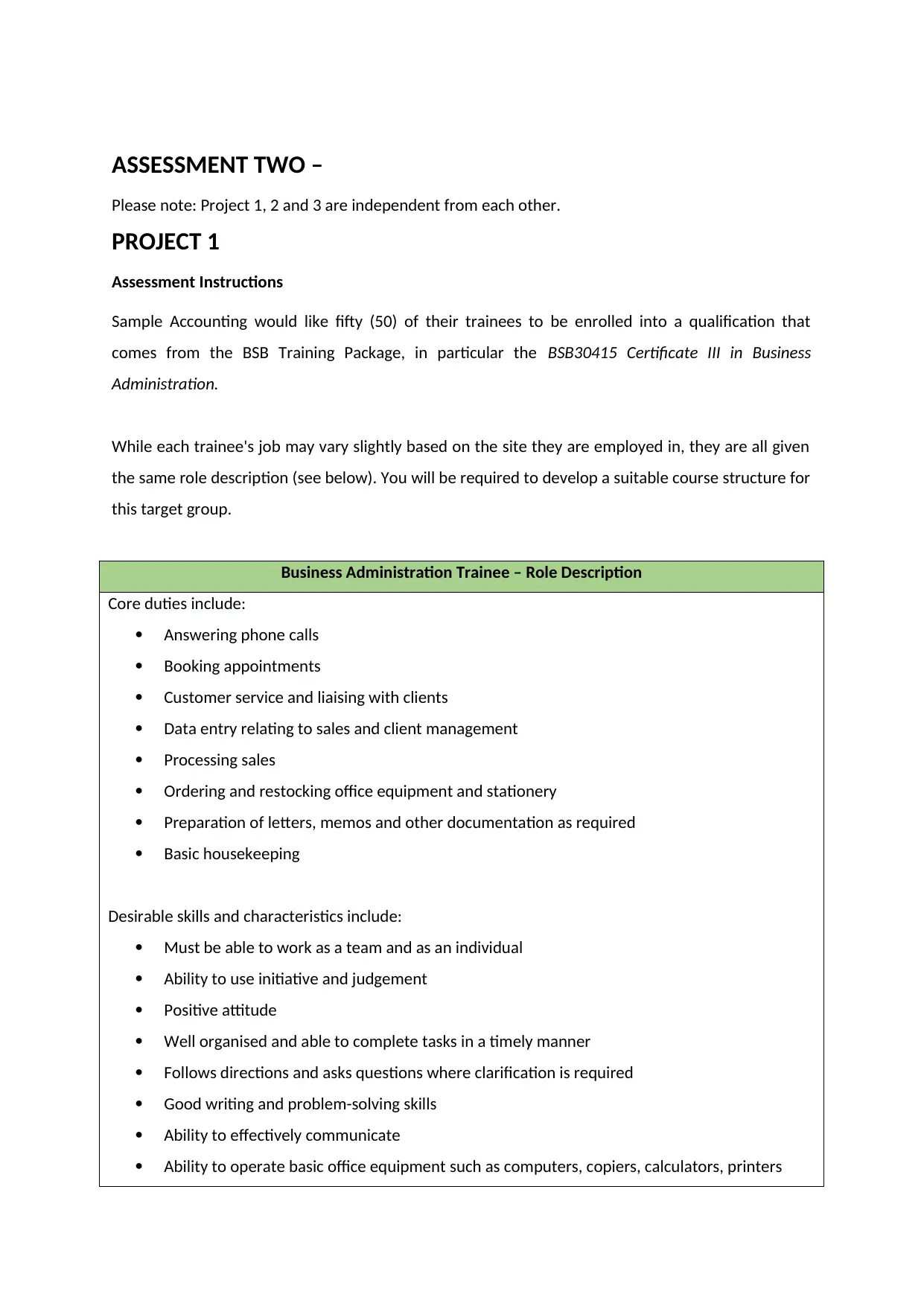
ASSESSMENT TWO –
Please note: Project 1, 2 and 3 are independent from each other.
PROJECT 1
Assessment Instructions
Sample Accounting would like fifty (50) of their trainees to be enrolled into a qualification that
comes from the BSB Training Package, in particular the BSB30415 Certificate III in Business
Administration.
While each trainee's job may vary slightly based on the site they are employed in, they are all given
the same role description (see below). You will be required to develop a suitable course structure for
this target group.
Business Administration Trainee – Role Description
Core duties include:
Answering phone calls
Booking appointments
Customer service and liaising with clients
Data entry relating to sales and client management
Processing sales
Ordering and restocking office equipment and stationery
Preparation of letters, memos and other documentation as required
Basic housekeeping
Desirable skills and characteristics include:
Must be able to work as a team and as an individual
Ability to use initiative and judgement
Positive attitude
Well organised and able to complete tasks in a timely manner
Follows directions and asks questions where clarification is required
Good writing and problem-solving skills
Ability to effectively communicate
Ability to operate basic office equipment such as computers, copiers, calculators, printers
Please note: Project 1, 2 and 3 are independent from each other.
PROJECT 1
Assessment Instructions
Sample Accounting would like fifty (50) of their trainees to be enrolled into a qualification that
comes from the BSB Training Package, in particular the BSB30415 Certificate III in Business
Administration.
While each trainee's job may vary slightly based on the site they are employed in, they are all given
the same role description (see below). You will be required to develop a suitable course structure for
this target group.
Business Administration Trainee – Role Description
Core duties include:
Answering phone calls
Booking appointments
Customer service and liaising with clients
Data entry relating to sales and client management
Processing sales
Ordering and restocking office equipment and stationery
Preparation of letters, memos and other documentation as required
Basic housekeeping
Desirable skills and characteristics include:
Must be able to work as a team and as an individual
Ability to use initiative and judgement
Positive attitude
Well organised and able to complete tasks in a timely manner
Follows directions and asks questions where clarification is required
Good writing and problem-solving skills
Ability to effectively communicate
Ability to operate basic office equipment such as computers, copiers, calculators, printers
Paraphrase This Document
Need a fresh take? Get an instant paraphrase of this document with our AI Paraphraser
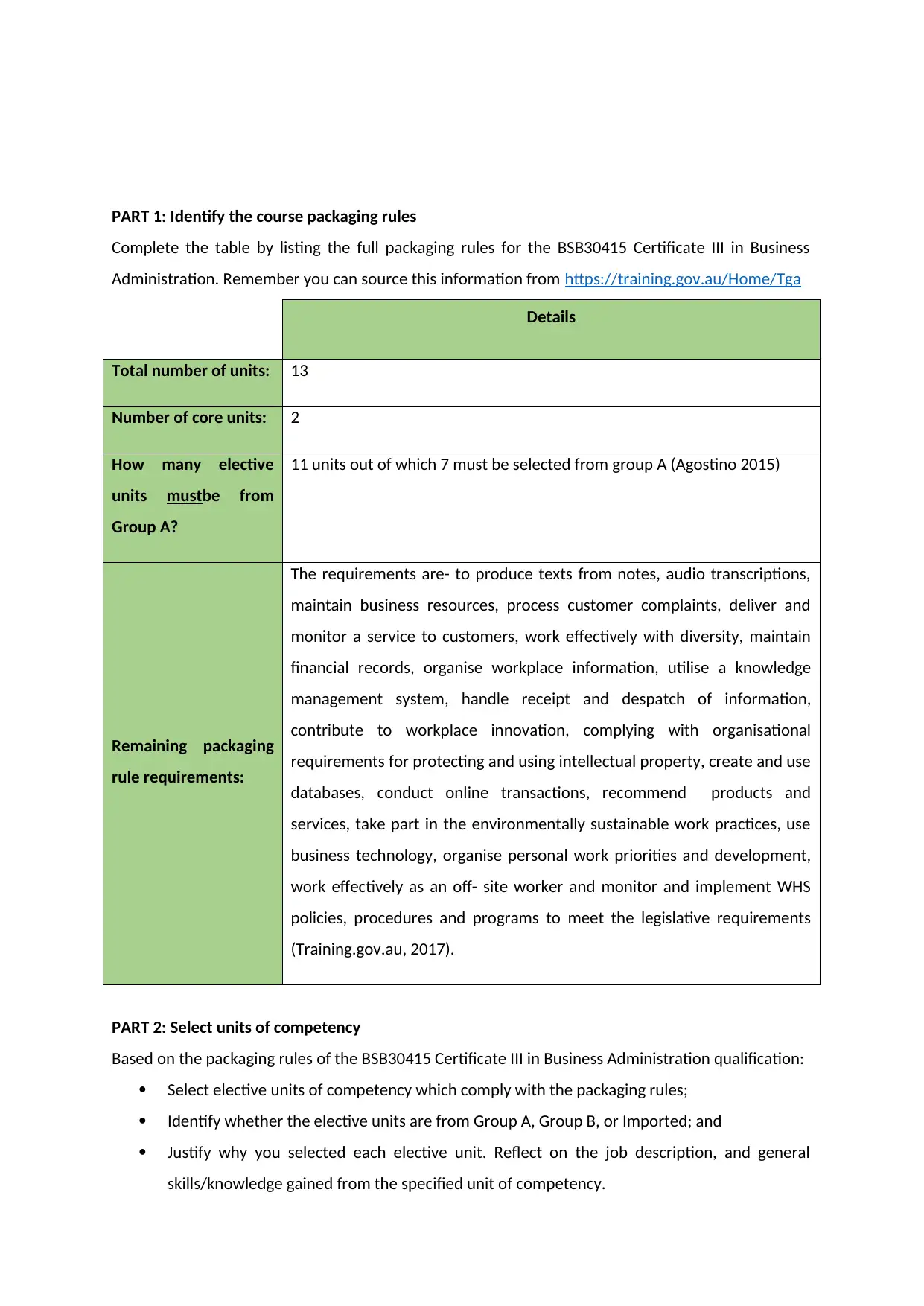
PART 1: Identify the course packaging rules
Complete the table by listing the full packaging rules for the BSB30415 Certificate III in Business
Administration. Remember you can source this information from https://training.gov.au/Home/Tga
Details
Total number of units: 13
Number of core units: 2
How many elective
units mustbe from
Group A?
11 units out of which 7 must be selected from group A (Agostino 2015)
Remaining packaging
rule requirements:
The requirements are- to produce texts from notes, audio transcriptions,
maintain business resources, process customer complaints, deliver and
monitor a service to customers, work effectively with diversity, maintain
financial records, organise workplace information, utilise a knowledge
management system, handle receipt and despatch of information,
contribute to workplace innovation, complying with organisational
requirements for protecting and using intellectual property, create and use
databases, conduct online transactions, recommend products and
services, take part in the environmentally sustainable work practices, use
business technology, organise personal work priorities and development,
work effectively as an off- site worker and monitor and implement WHS
policies, procedures and programs to meet the legislative requirements
(Training.gov.au, 2017).
PART 2: Select units of competency
Based on the packaging rules of the BSB30415 Certificate III in Business Administration qualification:
Select elective units of competency which comply with the packaging rules;
Identify whether the elective units are from Group A, Group B, or Imported; and
Justify why you selected each elective unit. Reflect on the job description, and general
skills/knowledge gained from the specified unit of competency.
Complete the table by listing the full packaging rules for the BSB30415 Certificate III in Business
Administration. Remember you can source this information from https://training.gov.au/Home/Tga
Details
Total number of units: 13
Number of core units: 2
How many elective
units mustbe from
Group A?
11 units out of which 7 must be selected from group A (Agostino 2015)
Remaining packaging
rule requirements:
The requirements are- to produce texts from notes, audio transcriptions,
maintain business resources, process customer complaints, deliver and
monitor a service to customers, work effectively with diversity, maintain
financial records, organise workplace information, utilise a knowledge
management system, handle receipt and despatch of information,
contribute to workplace innovation, complying with organisational
requirements for protecting and using intellectual property, create and use
databases, conduct online transactions, recommend products and
services, take part in the environmentally sustainable work practices, use
business technology, organise personal work priorities and development,
work effectively as an off- site worker and monitor and implement WHS
policies, procedures and programs to meet the legislative requirements
(Training.gov.au, 2017).
PART 2: Select units of competency
Based on the packaging rules of the BSB30415 Certificate III in Business Administration qualification:
Select elective units of competency which comply with the packaging rules;
Identify whether the elective units are from Group A, Group B, or Imported; and
Justify why you selected each elective unit. Reflect on the job description, and general
skills/knowledge gained from the specified unit of competency.
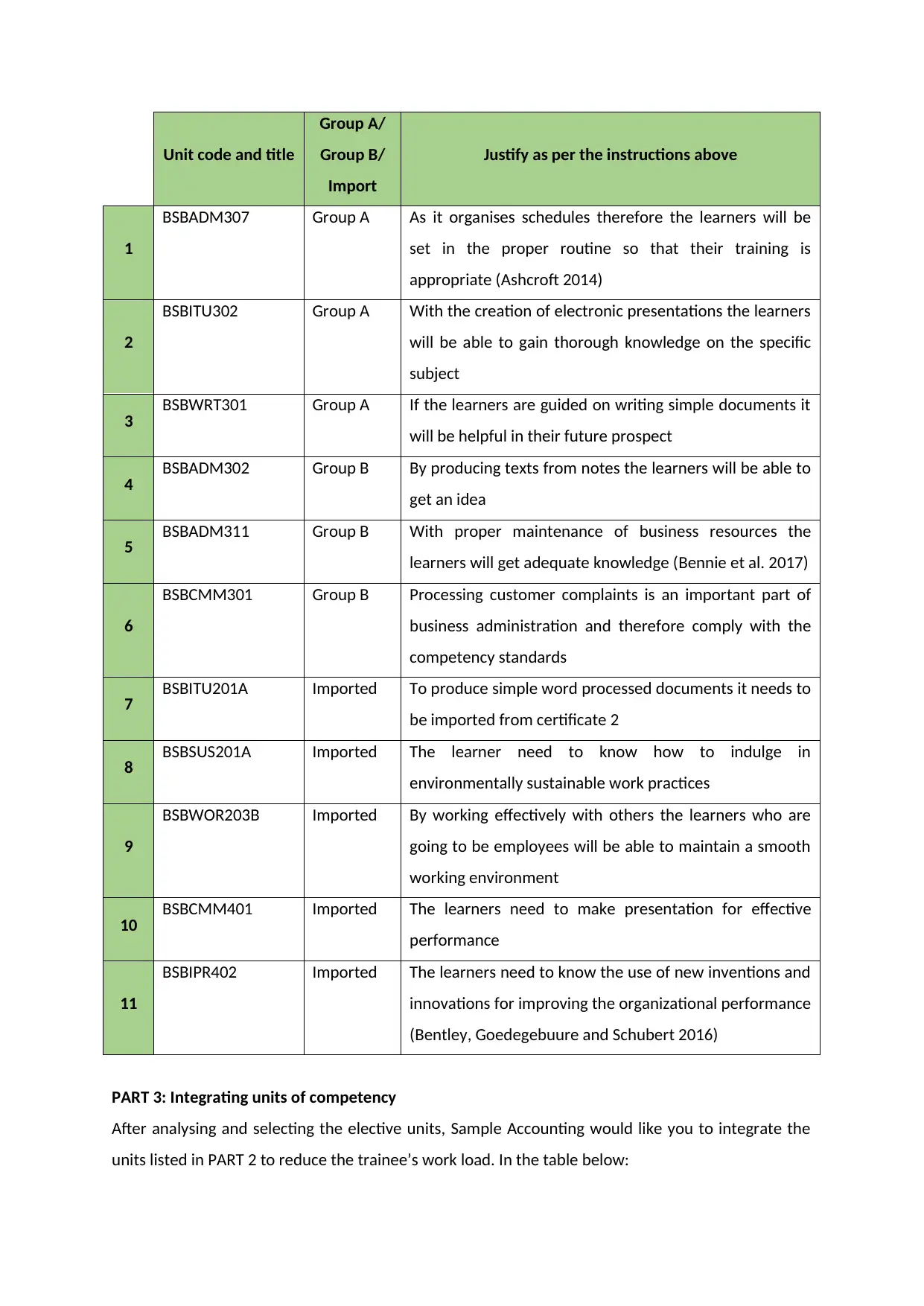
Unit code and title
Group A/
Group B/
Import
Justify as per the instructions above
1
BSBADM307 Group A As it organises schedules therefore the learners will be
set in the proper routine so that their training is
appropriate (Ashcroft 2014)
2
BSBITU302 Group A With the creation of electronic presentations the learners
will be able to gain thorough knowledge on the specific
subject
3 BSBWRT301 Group A If the learners are guided on writing simple documents it
will be helpful in their future prospect
4 BSBADM302 Group B By producing texts from notes the learners will be able to
get an idea
5 BSBADM311 Group B With proper maintenance of business resources the
learners will get adequate knowledge (Bennie et al. 2017)
6
BSBCMM301 Group B Processing customer complaints is an important part of
business administration and therefore comply with the
competency standards
7 BSBITU201A Imported To produce simple word processed documents it needs to
be imported from certificate 2
8 BSBSUS201A Imported The learner need to know how to indulge in
environmentally sustainable work practices
9
BSBWOR203B Imported By working effectively with others the learners who are
going to be employees will be able to maintain a smooth
working environment
10 BSBCMM401 Imported The learners need to make presentation for effective
performance
11
BSBIPR402 Imported The learners need to know the use of new inventions and
innovations for improving the organizational performance
(Bentley, Goedegebuure and Schubert 2016)
PART 3: Integrating units of competency
After analysing and selecting the elective units, Sample Accounting would like you to integrate the
units listed in PART 2 to reduce the trainee’s work load. In the table below:
Group A/
Group B/
Import
Justify as per the instructions above
1
BSBADM307 Group A As it organises schedules therefore the learners will be
set in the proper routine so that their training is
appropriate (Ashcroft 2014)
2
BSBITU302 Group A With the creation of electronic presentations the learners
will be able to gain thorough knowledge on the specific
subject
3 BSBWRT301 Group A If the learners are guided on writing simple documents it
will be helpful in their future prospect
4 BSBADM302 Group B By producing texts from notes the learners will be able to
get an idea
5 BSBADM311 Group B With proper maintenance of business resources the
learners will get adequate knowledge (Bennie et al. 2017)
6
BSBCMM301 Group B Processing customer complaints is an important part of
business administration and therefore comply with the
competency standards
7 BSBITU201A Imported To produce simple word processed documents it needs to
be imported from certificate 2
8 BSBSUS201A Imported The learner need to know how to indulge in
environmentally sustainable work practices
9
BSBWOR203B Imported By working effectively with others the learners who are
going to be employees will be able to maintain a smooth
working environment
10 BSBCMM401 Imported The learners need to make presentation for effective
performance
11
BSBIPR402 Imported The learners need to know the use of new inventions and
innovations for improving the organizational performance
(Bentley, Goedegebuure and Schubert 2016)
PART 3: Integrating units of competency
After analysing and selecting the elective units, Sample Accounting would like you to integrate the
units listed in PART 2 to reduce the trainee’s work load. In the table below:
⊘ This is a preview!⊘
Do you want full access?
Subscribe today to unlock all pages.

Trusted by 1+ million students worldwide

Select two (2) elective units of competency which could be suitable for integration; and
Explain why it would be appropriate to link the selected units. Provide examples to support
your reasoning.
Unit code and title Explanation and example
1
BSBADM307
Organise Schedules
This will be easy to integrate as it is easy to grasp by the learners
and do not have a lot within it (Berryman 2016)
2
BSBADM302
Produce texts from notes
This unit of competency would be suitable for integration as
there are a number of ways to produce texts either from notes
or from audio transcription (Billett et al. 2015)
PART 4: Research contextualisation guidelines of the training package developer
Research the contextualisation advice provided by the training package developer of
BSB30415Certificate III in Business Administration. You must copy and paste the information into the
text box below.
The contextualisation advice provided by the training package developer are-
o ISCs must notify STAs and the Department of ISC Upgrades of Training Packages identifying all changes.
o STAs will advise relevant RTOs (Blacker et al. 2015).
o Each industry Training Package has a five-character code followed by a unique and concise title
reflecting the industry covered. For example, in the TAA08 Training and Assessment Training Package,
’TAA’ identifies the industry area, ’08’ identifies the year of endorsement, and the title reflects its industry
coverage. When assigning Training Package codes and titles Training Package developers must: always
use the code in full, followed by the title not use spaces between any characters in the code use
uppercase letters and Arabic figures (Bowman and McKenna 2016) not use ampersands, full stops or
slashes use a title that is unique, concise and reflects the broad industry covered not use the words
‘Australian’ or ‘National’ in the title, except by special permission from the Department use ‘Z’ as the
first letter in enterprise Training Packages if a new industry sector is added during the endorsement
period, retain the Training Package’s original endorsement year code. o It is important that developers
do not confuse the Training Package code (which remains the same during the endorsement period) with
the version number (which can change in the endorsement period). o The code of a reviewed Training
Package must reflect the endorsement year of the review. o Where the whole Training Package is
reviewed, its code changes and it is considered to be a new Training Package for the purposes of version
Explain why it would be appropriate to link the selected units. Provide examples to support
your reasoning.
Unit code and title Explanation and example
1
BSBADM307
Organise Schedules
This will be easy to integrate as it is easy to grasp by the learners
and do not have a lot within it (Berryman 2016)
2
BSBADM302
Produce texts from notes
This unit of competency would be suitable for integration as
there are a number of ways to produce texts either from notes
or from audio transcription (Billett et al. 2015)
PART 4: Research contextualisation guidelines of the training package developer
Research the contextualisation advice provided by the training package developer of
BSB30415Certificate III in Business Administration. You must copy and paste the information into the
text box below.
The contextualisation advice provided by the training package developer are-
o ISCs must notify STAs and the Department of ISC Upgrades of Training Packages identifying all changes.
o STAs will advise relevant RTOs (Blacker et al. 2015).
o Each industry Training Package has a five-character code followed by a unique and concise title
reflecting the industry covered. For example, in the TAA08 Training and Assessment Training Package,
’TAA’ identifies the industry area, ’08’ identifies the year of endorsement, and the title reflects its industry
coverage. When assigning Training Package codes and titles Training Package developers must: always
use the code in full, followed by the title not use spaces between any characters in the code use
uppercase letters and Arabic figures (Bowman and McKenna 2016) not use ampersands, full stops or
slashes use a title that is unique, concise and reflects the broad industry covered not use the words
‘Australian’ or ‘National’ in the title, except by special permission from the Department use ‘Z’ as the
first letter in enterprise Training Packages if a new industry sector is added during the endorsement
period, retain the Training Package’s original endorsement year code. o It is important that developers
do not confuse the Training Package code (which remains the same during the endorsement period) with
the version number (which can change in the endorsement period). o The code of a reviewed Training
Package must reflect the endorsement year of the review. o Where the whole Training Package is
reviewed, its code changes and it is considered to be a new Training Package for the purposes of version
Paraphrase This Document
Need a fresh take? Get an instant paraphrase of this document with our AI Paraphraser
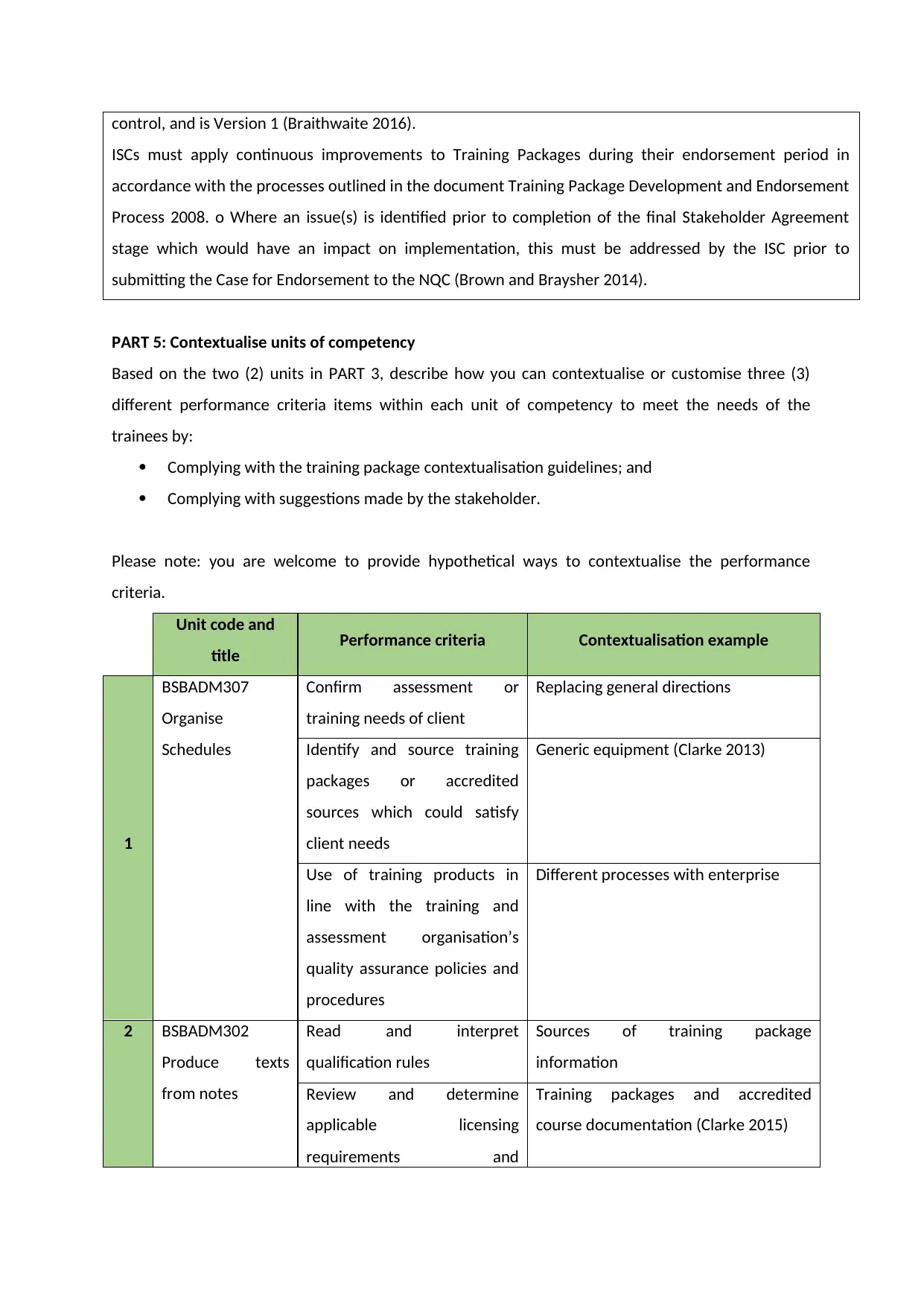
control, and is Version 1 (Braithwaite 2016).
ISCs must apply continuous improvements to Training Packages during their endorsement period in
accordance with the processes outlined in the document Training Package Development and Endorsement
Process 2008. o Where an issue(s) is identified prior to completion of the final Stakeholder Agreement
stage which would have an impact on implementation, this must be addressed by the ISC prior to
submitting the Case for Endorsement to the NQC (Brown and Braysher 2014).
PART 5: Contextualise units of competency
Based on the two (2) units in PART 3, describe how you can contextualise or customise three (3)
different performance criteria items within each unit of competency to meet the needs of the
trainees by:
Complying with the training package contextualisation guidelines; and
Complying with suggestions made by the stakeholder.
Please note: you are welcome to provide hypothetical ways to contextualise the performance
criteria.
Unit code and
title Performance criteria Contextualisation example
1
BSBADM307
Organise
Schedules
Confirm assessment or
training needs of client
Replacing general directions
Identify and source training
packages or accredited
sources which could satisfy
client needs
Generic equipment (Clarke 2013)
Use of training products in
line with the training and
assessment organisation’s
quality assurance policies and
procedures
Different processes with enterprise
2 BSBADM302
Produce texts
from notes
Read and interpret
qualification rules
Sources of training package
information
Review and determine
applicable licensing
requirements and
Training packages and accredited
course documentation (Clarke 2015)
ISCs must apply continuous improvements to Training Packages during their endorsement period in
accordance with the processes outlined in the document Training Package Development and Endorsement
Process 2008. o Where an issue(s) is identified prior to completion of the final Stakeholder Agreement
stage which would have an impact on implementation, this must be addressed by the ISC prior to
submitting the Case for Endorsement to the NQC (Brown and Braysher 2014).
PART 5: Contextualise units of competency
Based on the two (2) units in PART 3, describe how you can contextualise or customise three (3)
different performance criteria items within each unit of competency to meet the needs of the
trainees by:
Complying with the training package contextualisation guidelines; and
Complying with suggestions made by the stakeholder.
Please note: you are welcome to provide hypothetical ways to contextualise the performance
criteria.
Unit code and
title Performance criteria Contextualisation example
1
BSBADM307
Organise
Schedules
Confirm assessment or
training needs of client
Replacing general directions
Identify and source training
packages or accredited
sources which could satisfy
client needs
Generic equipment (Clarke 2013)
Use of training products in
line with the training and
assessment organisation’s
quality assurance policies and
procedures
Different processes with enterprise
2 BSBADM302
Produce texts
from notes
Read and interpret
qualification rules
Sources of training package
information
Review and determine
applicable licensing
requirements and
Training packages and accredited
course documentation (Clarke 2015)

prerequisites
Determine suitable electives
that meet client needs and job
roles
Identifying specific types of tools and
equipment relevant to competency
Determine suitable electives
that meet client needs and job
roles
Identifying specific types of tools and
equipment relevant to competency
⊘ This is a preview!⊘
Do you want full access?
Subscribe today to unlock all pages.

Trusted by 1+ million students worldwide

PROJECT 2
Design and develop one (1) learning program that is based on a full qualification. The learning
program must:
Be based on a nationally recognised qualification sourced from www.training.gov.au
The usage recommendation for the qualification must be current (not superseded)
Mandatory conditions of Project 2:
Condition 1
Throughout this project, you will be required to access RTO protocols, policies and procedures from
www.trainingrto.com
Condition 2
Your VET mentor must provide evidence of the following:
TAE40110 Certificate IV in Training and Assessment (testamur and record of results)
Condition 3
Each learning program will be based on the candidate’s needs and characteristics.
Condition 4
Each learning program must address different client needs, contexts and timelines.
Condition 5
You must provide evidence of Part 1 – 5.
Learning program
The art of designing and developing a learning
program within outcome based education and
training requires identification of the outcomes
that will be attained by the learner and then
conduct all the planning activities on the basis of
those outcomes.
This refers to all the aspects of learning program
starting from the facilities to the assessment
activities which need to be based on the learning
outcome of the program (Gemici et al. 2014).
The issues to be addressed during the program-
Identifying the outcomes
Identifying stakeholders
All the aspects need to be planned
Copyright issues
Evaluate the existing materials of
learning
Step by step development of the
learning materials
Step by step formulation of learning and
Design and develop one (1) learning program that is based on a full qualification. The learning
program must:
Be based on a nationally recognised qualification sourced from www.training.gov.au
The usage recommendation for the qualification must be current (not superseded)
Mandatory conditions of Project 2:
Condition 1
Throughout this project, you will be required to access RTO protocols, policies and procedures from
www.trainingrto.com
Condition 2
Your VET mentor must provide evidence of the following:
TAE40110 Certificate IV in Training and Assessment (testamur and record of results)
Condition 3
Each learning program will be based on the candidate’s needs and characteristics.
Condition 4
Each learning program must address different client needs, contexts and timelines.
Condition 5
You must provide evidence of Part 1 – 5.
Learning program
The art of designing and developing a learning
program within outcome based education and
training requires identification of the outcomes
that will be attained by the learner and then
conduct all the planning activities on the basis of
those outcomes.
This refers to all the aspects of learning program
starting from the facilities to the assessment
activities which need to be based on the learning
outcome of the program (Gemici et al. 2014).
The issues to be addressed during the program-
Identifying the outcomes
Identifying stakeholders
All the aspects need to be planned
Copyright issues
Evaluate the existing materials of
learning
Step by step development of the
learning materials
Step by step formulation of learning and
Paraphrase This Document
Need a fresh take? Get an instant paraphrase of this document with our AI Paraphraser

The trainer should have deep and detailed
knowledge and skills which are required for
following the steps in the planning process. Such
steps include the critical issue of designing
different learning resources which are based on
outcomes and appropriate for the program as
well as its outcome (Hodge 2014).
Moreover, the trainer needs to have a wide
knowledge of the different methods of carrying
out a learning program. Precisely, there are
several issues which the learning materials and
program designer has to take into consideration.
This particular program will consist of 2 unit
standards with a total of 25 credits at the level of
5 and 6 which are covered in 7 days by means of
an intensive small group training intervention.-
1. Design outcomes based learning
program
2. Develop outcomes based learning
program
The trainers who have enough experience are
responsible for conducting this program and the
underlying theoretical concepts are again
improved by the introduction various practical
examples of the individual duties required in the
learning program. This will reflect the role of
individual who are delivering training and
assessment services in the specific sector. The
communication skill that is required for the
learners is to interpret the needs of the clients
using the effective interpersonal skills (Hodge et
al. 2017).
assessment instruments
The requirements are-
A knowledge questionnaire
Completion of a detailed portfolio of
evidence within 6 months of the
training program
How the program works-
Registration for training in the suggested
venue
Complete the 5- day training including
the building of the assistance for
Portfolio of evidence
Complete the portfolio of evidence
which will include the knowledge
questionnaire
Submission of the portfolio for
assessment
The successful candidates’ results are
submitted
Certificates are issued
All the data are kept for future reference
Cost
7 day program- au$ 148
The training program includes the study
material, training, assessment and portfolio
building. Lunch and refreshments are also
included. The learners will have to arrange for
accommodation and travel by themselves
(Jacobson 2015).
knowledge and skills which are required for
following the steps in the planning process. Such
steps include the critical issue of designing
different learning resources which are based on
outcomes and appropriate for the program as
well as its outcome (Hodge 2014).
Moreover, the trainer needs to have a wide
knowledge of the different methods of carrying
out a learning program. Precisely, there are
several issues which the learning materials and
program designer has to take into consideration.
This particular program will consist of 2 unit
standards with a total of 25 credits at the level of
5 and 6 which are covered in 7 days by means of
an intensive small group training intervention.-
1. Design outcomes based learning
program
2. Develop outcomes based learning
program
The trainers who have enough experience are
responsible for conducting this program and the
underlying theoretical concepts are again
improved by the introduction various practical
examples of the individual duties required in the
learning program. This will reflect the role of
individual who are delivering training and
assessment services in the specific sector. The
communication skill that is required for the
learners is to interpret the needs of the clients
using the effective interpersonal skills (Hodge et
al. 2017).
assessment instruments
The requirements are-
A knowledge questionnaire
Completion of a detailed portfolio of
evidence within 6 months of the
training program
How the program works-
Registration for training in the suggested
venue
Complete the 5- day training including
the building of the assistance for
Portfolio of evidence
Complete the portfolio of evidence
which will include the knowledge
questionnaire
Submission of the portfolio for
assessment
The successful candidates’ results are
submitted
Certificates are issued
All the data are kept for future reference
Cost
7 day program- au$ 148
The training program includes the study
material, training, assessment and portfolio
building. Lunch and refreshments are also
included. The learners will have to arrange for
accommodation and travel by themselves
(Jacobson 2015).
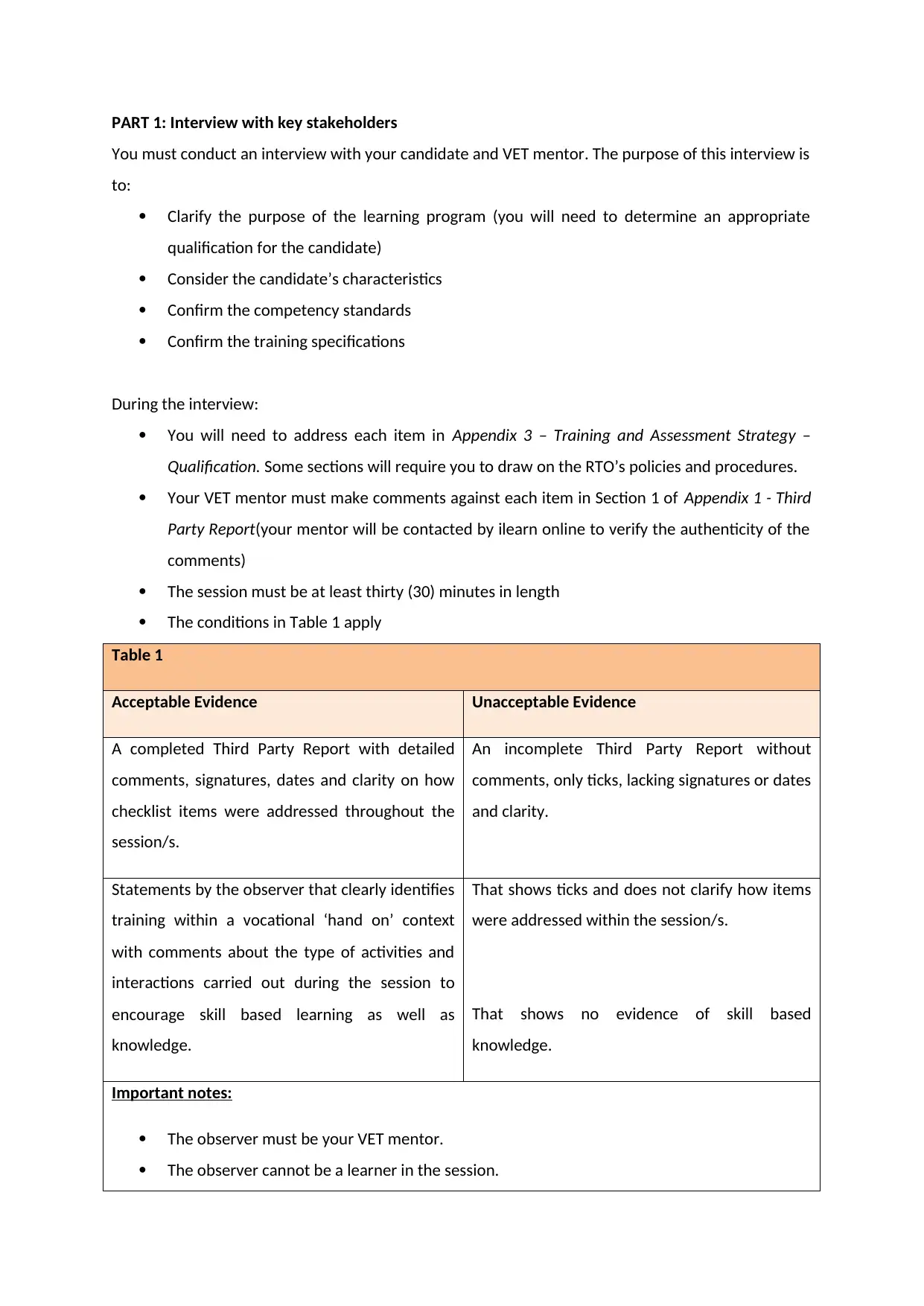
PART 1: Interview with key stakeholders
You must conduct an interview with your candidate and VET mentor. The purpose of this interview is
to:
Clarify the purpose of the learning program (you will need to determine an appropriate
qualification for the candidate)
Consider the candidate’s characteristics
Confirm the competency standards
Confirm the training specifications
During the interview:
You will need to address each item in Appendix 3 – Training and Assessment Strategy –
Qualification. Some sections will require you to draw on the RTO’s policies and procedures.
Your VET mentor must make comments against each item in Section 1 of Appendix 1 - Third
Party Report(your mentor will be contacted by ilearn online to verify the authenticity of the
comments)
The session must be at least thirty (30) minutes in length
The conditions in Table 1 apply
Table 1
Acceptable Evidence Unacceptable Evidence
A completed Third Party Report with detailed
comments, signatures, dates and clarity on how
checklist items were addressed throughout the
session/s.
An incomplete Third Party Report without
comments, only ticks, lacking signatures or dates
and clarity.
Statements by the observer that clearly identifies
training within a vocational ‘hand on’ context
with comments about the type of activities and
interactions carried out during the session to
encourage skill based learning as well as
knowledge.
That shows ticks and does not clarify how items
were addressed within the session/s.
That shows no evidence of skill based
knowledge.
Important notes:
The observer must be your VET mentor.
The observer cannot be a learner in the session.
You must conduct an interview with your candidate and VET mentor. The purpose of this interview is
to:
Clarify the purpose of the learning program (you will need to determine an appropriate
qualification for the candidate)
Consider the candidate’s characteristics
Confirm the competency standards
Confirm the training specifications
During the interview:
You will need to address each item in Appendix 3 – Training and Assessment Strategy –
Qualification. Some sections will require you to draw on the RTO’s policies and procedures.
Your VET mentor must make comments against each item in Section 1 of Appendix 1 - Third
Party Report(your mentor will be contacted by ilearn online to verify the authenticity of the
comments)
The session must be at least thirty (30) minutes in length
The conditions in Table 1 apply
Table 1
Acceptable Evidence Unacceptable Evidence
A completed Third Party Report with detailed
comments, signatures, dates and clarity on how
checklist items were addressed throughout the
session/s.
An incomplete Third Party Report without
comments, only ticks, lacking signatures or dates
and clarity.
Statements by the observer that clearly identifies
training within a vocational ‘hand on’ context
with comments about the type of activities and
interactions carried out during the session to
encourage skill based learning as well as
knowledge.
That shows ticks and does not clarify how items
were addressed within the session/s.
That shows no evidence of skill based
knowledge.
Important notes:
The observer must be your VET mentor.
The observer cannot be a learner in the session.
⊘ This is a preview!⊘
Do you want full access?
Subscribe today to unlock all pages.

Trusted by 1+ million students worldwide
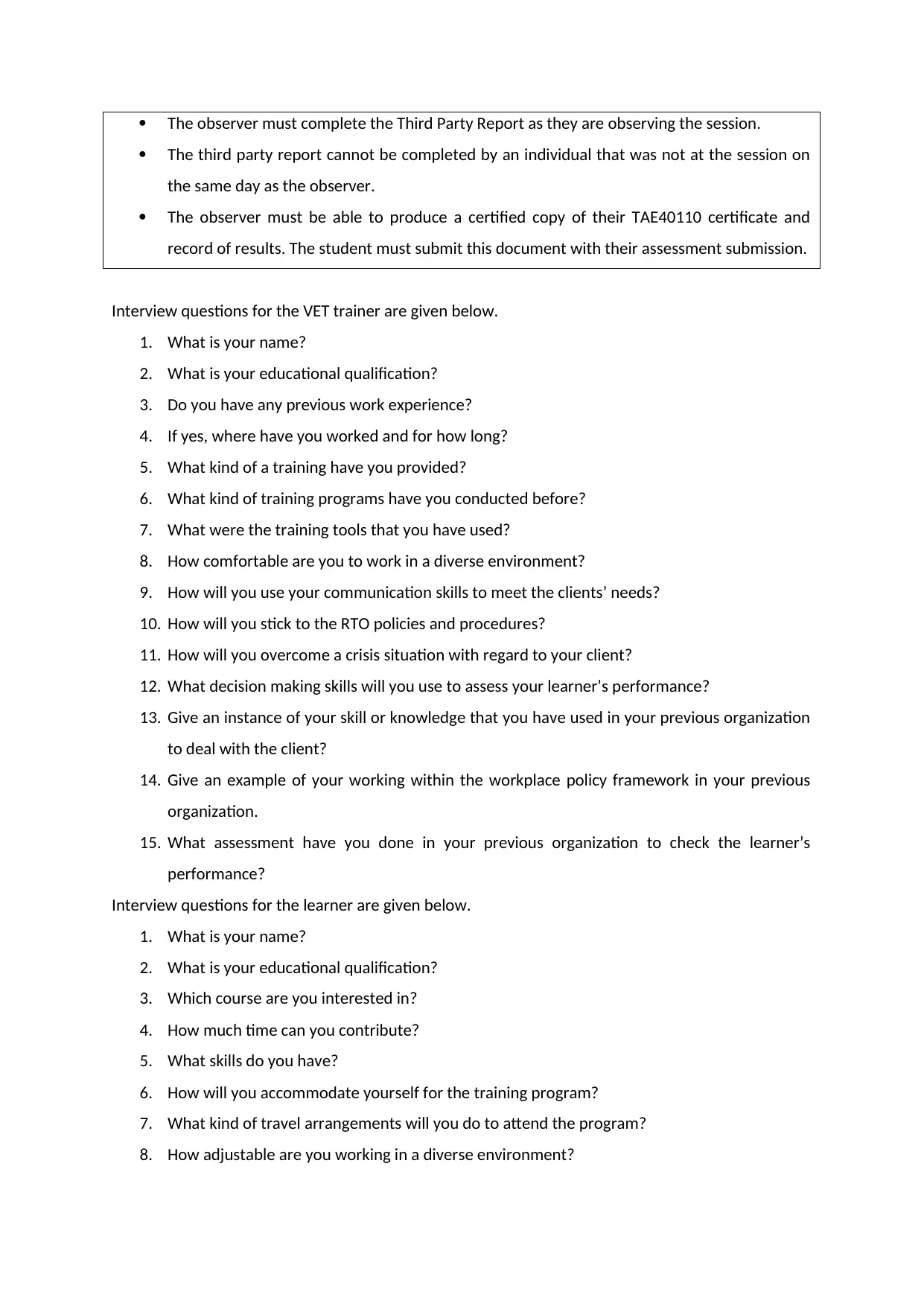
The observer must complete the Third Party Report as they are observing the session.
The third party report cannot be completed by an individual that was not at the session on
the same day as the observer.
The observer must be able to produce a certified copy of their TAE40110 certificate and
record of results. The student must submit this document with their assessment submission.
Interview questions for the VET trainer are given below.
1. What is your name?
2. What is your educational qualification?
3. Do you have any previous work experience?
4. If yes, where have you worked and for how long?
5. What kind of a training have you provided?
6. What kind of training programs have you conducted before?
7. What were the training tools that you have used?
8. How comfortable are you to work in a diverse environment?
9. How will you use your communication skills to meet the clients’ needs?
10. How will you stick to the RTO policies and procedures?
11. How will you overcome a crisis situation with regard to your client?
12. What decision making skills will you use to assess your learner’s performance?
13. Give an instance of your skill or knowledge that you have used in your previous organization
to deal with the client?
14. Give an example of your working within the workplace policy framework in your previous
organization.
15. What assessment have you done in your previous organization to check the learner’s
performance?
Interview questions for the learner are given below.
1. What is your name?
2. What is your educational qualification?
3. Which course are you interested in?
4. How much time can you contribute?
5. What skills do you have?
6. How will you accommodate yourself for the training program?
7. What kind of travel arrangements will you do to attend the program?
8. How adjustable are you working in a diverse environment?
The third party report cannot be completed by an individual that was not at the session on
the same day as the observer.
The observer must be able to produce a certified copy of their TAE40110 certificate and
record of results. The student must submit this document with their assessment submission.
Interview questions for the VET trainer are given below.
1. What is your name?
2. What is your educational qualification?
3. Do you have any previous work experience?
4. If yes, where have you worked and for how long?
5. What kind of a training have you provided?
6. What kind of training programs have you conducted before?
7. What were the training tools that you have used?
8. How comfortable are you to work in a diverse environment?
9. How will you use your communication skills to meet the clients’ needs?
10. How will you stick to the RTO policies and procedures?
11. How will you overcome a crisis situation with regard to your client?
12. What decision making skills will you use to assess your learner’s performance?
13. Give an instance of your skill or knowledge that you have used in your previous organization
to deal with the client?
14. Give an example of your working within the workplace policy framework in your previous
organization.
15. What assessment have you done in your previous organization to check the learner’s
performance?
Interview questions for the learner are given below.
1. What is your name?
2. What is your educational qualification?
3. Which course are you interested in?
4. How much time can you contribute?
5. What skills do you have?
6. How will you accommodate yourself for the training program?
7. What kind of travel arrangements will you do to attend the program?
8. How adjustable are you working in a diverse environment?
Paraphrase This Document
Need a fresh take? Get an instant paraphrase of this document with our AI Paraphraser
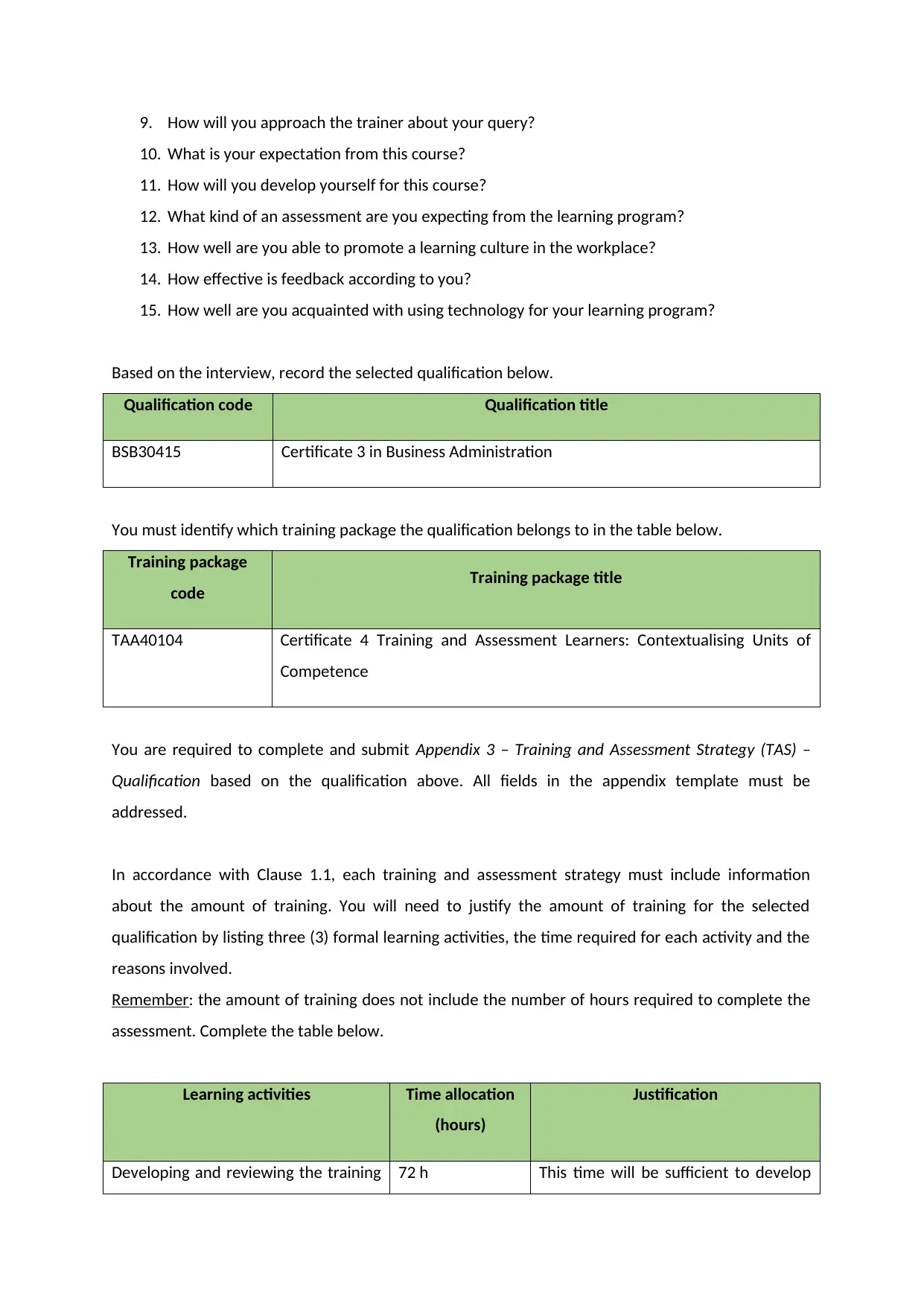
9. How will you approach the trainer about your query?
10. What is your expectation from this course?
11. How will you develop yourself for this course?
12. What kind of an assessment are you expecting from the learning program?
13. How well are you able to promote a learning culture in the workplace?
14. How effective is feedback according to you?
15. How well are you acquainted with using technology for your learning program?
Based on the interview, record the selected qualification below.
Qualification code Qualification title
BSB30415 Certificate 3 in Business Administration
You must identify which training package the qualification belongs to in the table below.
Training package
code Training package title
TAA40104 Certificate 4 Training and Assessment Learners: Contextualising Units of
Competence
You are required to complete and submit Appendix 3 – Training and Assessment Strategy (TAS) –
Qualification based on the qualification above. All fields in the appendix template must be
addressed.
In accordance with Clause 1.1, each training and assessment strategy must include information
about the amount of training. You will need to justify the amount of training for the selected
qualification by listing three (3) formal learning activities, the time required for each activity and the
reasons involved.
Remember: the amount of training does not include the number of hours required to complete the
assessment. Complete the table below.
Learning activities Time allocation
(hours)
Justification
Developing and reviewing the training 72 h This time will be sufficient to develop
10. What is your expectation from this course?
11. How will you develop yourself for this course?
12. What kind of an assessment are you expecting from the learning program?
13. How well are you able to promote a learning culture in the workplace?
14. How effective is feedback according to you?
15. How well are you acquainted with using technology for your learning program?
Based on the interview, record the selected qualification below.
Qualification code Qualification title
BSB30415 Certificate 3 in Business Administration
You must identify which training package the qualification belongs to in the table below.
Training package
code Training package title
TAA40104 Certificate 4 Training and Assessment Learners: Contextualising Units of
Competence
You are required to complete and submit Appendix 3 – Training and Assessment Strategy (TAS) –
Qualification based on the qualification above. All fields in the appendix template must be
addressed.
In accordance with Clause 1.1, each training and assessment strategy must include information
about the amount of training. You will need to justify the amount of training for the selected
qualification by listing three (3) formal learning activities, the time required for each activity and the
reasons involved.
Remember: the amount of training does not include the number of hours required to complete the
assessment. Complete the table below.
Learning activities Time allocation
(hours)
Justification
Developing and reviewing the training 72 h This time will be sufficient to develop
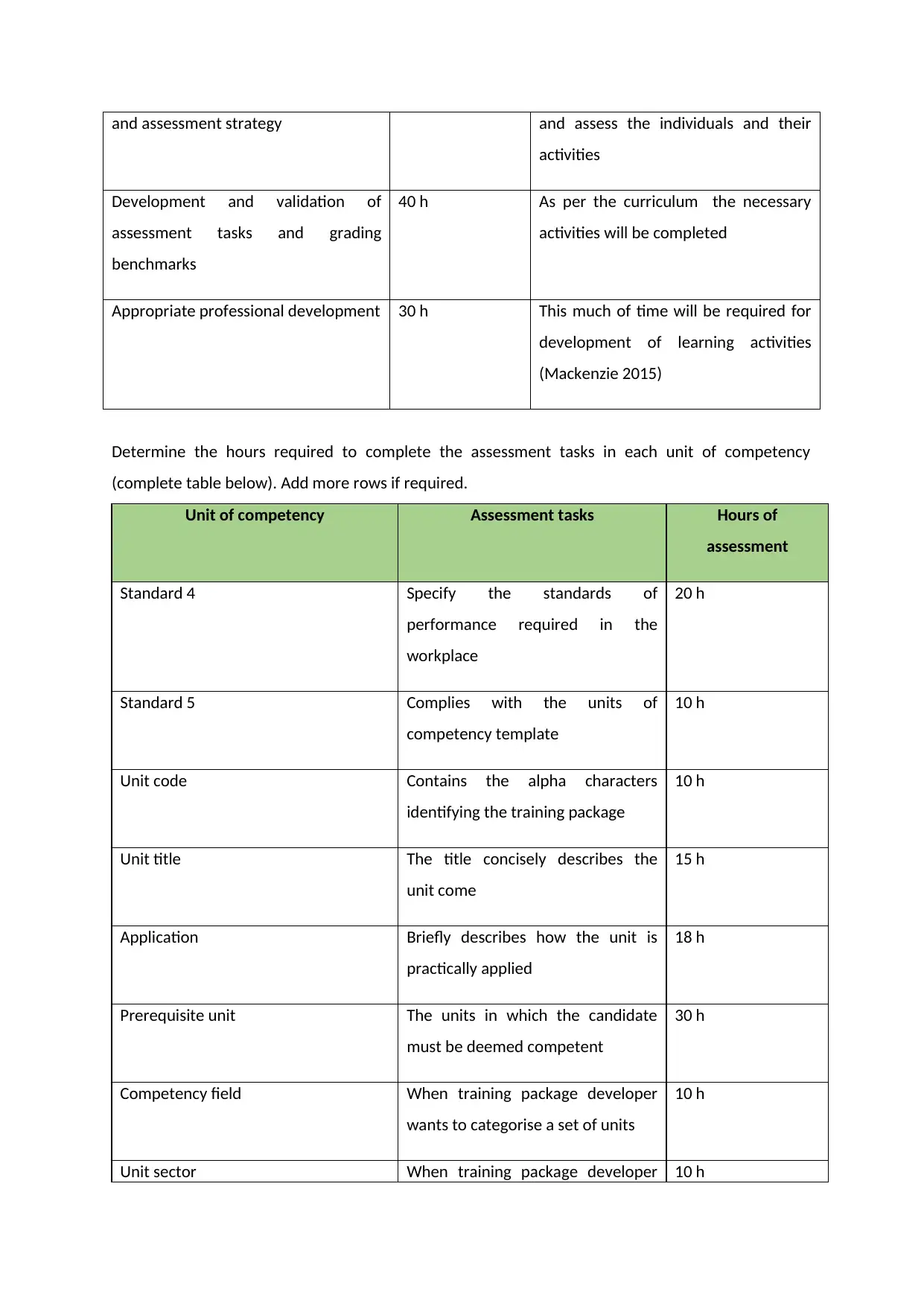
and assessment strategy and assess the individuals and their
activities
Development and validation of
assessment tasks and grading
benchmarks
40 h As per the curriculum the necessary
activities will be completed
Appropriate professional development 30 h This much of time will be required for
development of learning activities
(Mackenzie 2015)
Determine the hours required to complete the assessment tasks in each unit of competency
(complete table below). Add more rows if required.
Unit of competency Assessment tasks Hours of
assessment
Standard 4 Specify the standards of
performance required in the
workplace
20 h
Standard 5 Complies with the units of
competency template
10 h
Unit code Contains the alpha characters
identifying the training package
10 h
Unit title The title concisely describes the
unit come
15 h
Application Briefly describes how the unit is
practically applied
18 h
Prerequisite unit The units in which the candidate
must be deemed competent
30 h
Competency field When training package developer
wants to categorise a set of units
10 h
Unit sector When training package developer 10 h
activities
Development and validation of
assessment tasks and grading
benchmarks
40 h As per the curriculum the necessary
activities will be completed
Appropriate professional development 30 h This much of time will be required for
development of learning activities
(Mackenzie 2015)
Determine the hours required to complete the assessment tasks in each unit of competency
(complete table below). Add more rows if required.
Unit of competency Assessment tasks Hours of
assessment
Standard 4 Specify the standards of
performance required in the
workplace
20 h
Standard 5 Complies with the units of
competency template
10 h
Unit code Contains the alpha characters
identifying the training package
10 h
Unit title The title concisely describes the
unit come
15 h
Application Briefly describes how the unit is
practically applied
18 h
Prerequisite unit The units in which the candidate
must be deemed competent
30 h
Competency field When training package developer
wants to categorise a set of units
10 h
Unit sector When training package developer 10 h
⊘ This is a preview!⊘
Do you want full access?
Subscribe today to unlock all pages.

Trusted by 1+ million students worldwide
1 out of 50
Related Documents
Your All-in-One AI-Powered Toolkit for Academic Success.
+13062052269
info@desklib.com
Available 24*7 on WhatsApp / Email
![[object Object]](/_next/static/media/star-bottom.7253800d.svg)
Unlock your academic potential
Copyright © 2020–2025 A2Z Services. All Rights Reserved. Developed and managed by ZUCOL.




